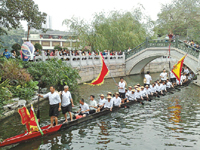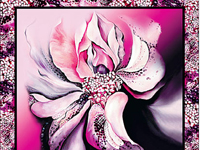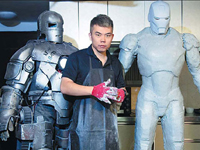Memorial swirls with the forces of China's history
Updated: 2012-12-20 10:26
By Raymond Zhou in Guangzhou (China Daily)
|
|||||||||||
In the 1920s and 30s, it was used as a sports academy. When it was occupied by Japanese invaders, it became their barracks. In 1950, it was a "cadre school" for training government officials.
The first revamp was the result of local people's representatives (congressmen) proposing to protect it as a cultural heritage. The school was moved out; a massive restoration project was started; thousands of exhibits were assembled.
On Oct 1, 1959, the compound opened to the public as Guangdong Folk Crafts Museum.
Unfortunately, this was not enough to shelter the cluster of buildings from ensuing political turmoil. At the start of the "cultural revolution" (1966-76), Red Guards destroyed everything that was old. They took the 10,000 shrine plaques and burned them, but they were talked out of demolishing the cornucopia of rooftop carvings by the museum staff.
As more of them came - and from places other than Guangzhou - presumably with even less knowledge of the temple and its historical value, they were surprised to find themselves in a printing shop churning out former leader Mao Zedong's "Little Red Book".
The museum, in desperation, had resorted to the tactic of moving in a factory as the "politically correct" gesture to forestall "revolutionary fervor".
In secret, the staff took down and relocated many engraved doors, windows and wooden plaques with calligraphy, thus preserving many of the old objects.
The printing shop might have scared away young zealots, but it attracted unsavory elements of another kind.
Not long after, another factory broke down part of the back wall and took the back yard. A school seized the front yard. An architectural gem was essentially engulfed by dense, ugly structures on all sides. Even a local resident had trouble locating it.
As soon as the political mania was over, people of Guangzhou called for the restoration of the compound to its former splendor.
But it took two more decades to clear all the debris of the political fallout.
Now, the Chen Family Temple looks better than ever. A square as big as the compound has been created, complete with a pair of flagpoles.
The ornate brick and wood carvings on the roofs and cornices have finally been given the prominence they are due. It is said to be a Western influence to have so much detail engraved in places where spectators have to strain their neck for a good look. A handful of shrines still stand in the main hall, a replica that hardly does justice to the sea of plaques that used to be there.
If you love Beijing's traditional courtyard houses, you'll love the Chen Family Temple because it is like an enlarged courtyard, or rather, half a dozen courtyards joined together, perfectly symmetrical and appropriately grand.
But look more closely, and you will see the unmistakably Cantonese touch.
raymondzhou@chinadaily.com.cn
Related Stories
Guangzhou: Mandarin Cats 2012-11-30 11:23
Tragedy in Guangzhou 2012-11-28 13:03
Guangzhou on its toes 2012-11-16 13:38
Hotel listings: Beijing, Shanghai, Guangzhou 2012-10-28 16:17
Guangzhou's dance, drama revolution 2012-10-19 09:37
Today's Top News
President Xi confident in recovery from quake
H7N9 update: 104 cases, 21 deaths
Telecom workers restore links
Coal mine blast kills 18 in Jilin
Intl scholarship puts China on the map
More bird flu patients discharged
Gold loses sheen, but still a safe bet
US 'turns blind eye to human rights'
Hot Topics
Lunar probe , China growth forecasts, Emission rules get tougher, China seen through 'colored lens', International board,
Editor's Picks

|

|

|

|

|

|








